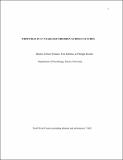Files in this item
White bias in 3-7 year-old children across cultures
Item metadata
| dc.contributor.author | Gibson, Bentley | |
| dc.contributor.author | Robbins, Erin | |
| dc.contributor.author | Rochat, Philippe | |
| dc.date.accessioned | 2018-01-15T16:30:08Z | |
| dc.date.available | 2018-01-15T16:30:08Z | |
| dc.date.issued | 2015 | |
| dc.identifier | 252067062 | |
| dc.identifier | c1f89607-e78f-4f1d-83e9-a53162fea0b4 | |
| dc.identifier | 84941268123 | |
| dc.identifier.citation | Gibson , B , Robbins , E & Rochat , P 2015 , ' White bias in 3-7 year-old children across cultures ' , Journal of Cognition and Culture , vol. 15 , no. 3-4 , pp. 344-373 . https://doi.org/10.1163/15685373-12342155 | en |
| dc.identifier.issn | 1567-7095 | |
| dc.identifier.other | ORCID: /0000-0003-0404-453X/work/65014383 | |
| dc.identifier.uri | https://hdl.handle.net/10023/12482 | |
| dc.description.abstract | In three studies we report data confirming and extending the finding of a tendency toward a White preference bias by young children of various ethnic backgrounds. European American preschoolers who identify with a White doll also prefer it to a Black doll. In contrast, same age African American children who identify with a Black doll do not show a significant preference for it over a White doll. These results are comparable in African American children attending either a racially mixed (heterogeneous), or an Afro-centric, all African American (homogenous) preschool. These results show the persistence of an observation that contributed to school de-segregation in the United States. Results also reveal a lack of congruence between skin color identity and preference is not limited to African Americans. There is a comparable, if not stronger White preference bias in five to seven-year-old Polynesian and Melanesian children tested in their native island nations. Using a modified procedure controlling for binary forced choice biases, we confirm these findings with second generation American children of Indian descent showing clear signs of a White (lighter skin preference) bias. These results are consistent with the idea that during the preschool years children are sensitive and attracted to signs of higher social status that, for historical reasons and across cultures, tends to be associated with lighter skin color. | |
| dc.format.extent | 1206264 | |
| dc.language.iso | eng | |
| dc.relation.ispartof | Journal of Cognition and Culture | en |
| dc.subject | Bias | en |
| dc.subject | Children | en |
| dc.subject | Cross cultural | en |
| dc.subject | Development | en |
| dc.subject | Ethnicity | en |
| dc.subject | Preferences | en |
| dc.subject | Race | en |
| dc.subject | BF Psychology | en |
| dc.subject | NDAS | en |
| dc.subject.lcc | BF | en |
| dc.title | White bias in 3-7 year-old children across cultures | en |
| dc.type | Journal article | en |
| dc.contributor.institution | University of St Andrews. School of Psychology and Neuroscience | en |
| dc.contributor.institution | University of St Andrews. Centre for Social Learning & Cognitive Evolution | en |
| dc.identifier.doi | https://doi.org/10.1163/15685373-12342155 | |
| dc.description.status | Peer reviewed | en |
This item appears in the following Collection(s)
Items in the St Andrews Research Repository are protected by copyright, with all rights reserved, unless otherwise indicated.

